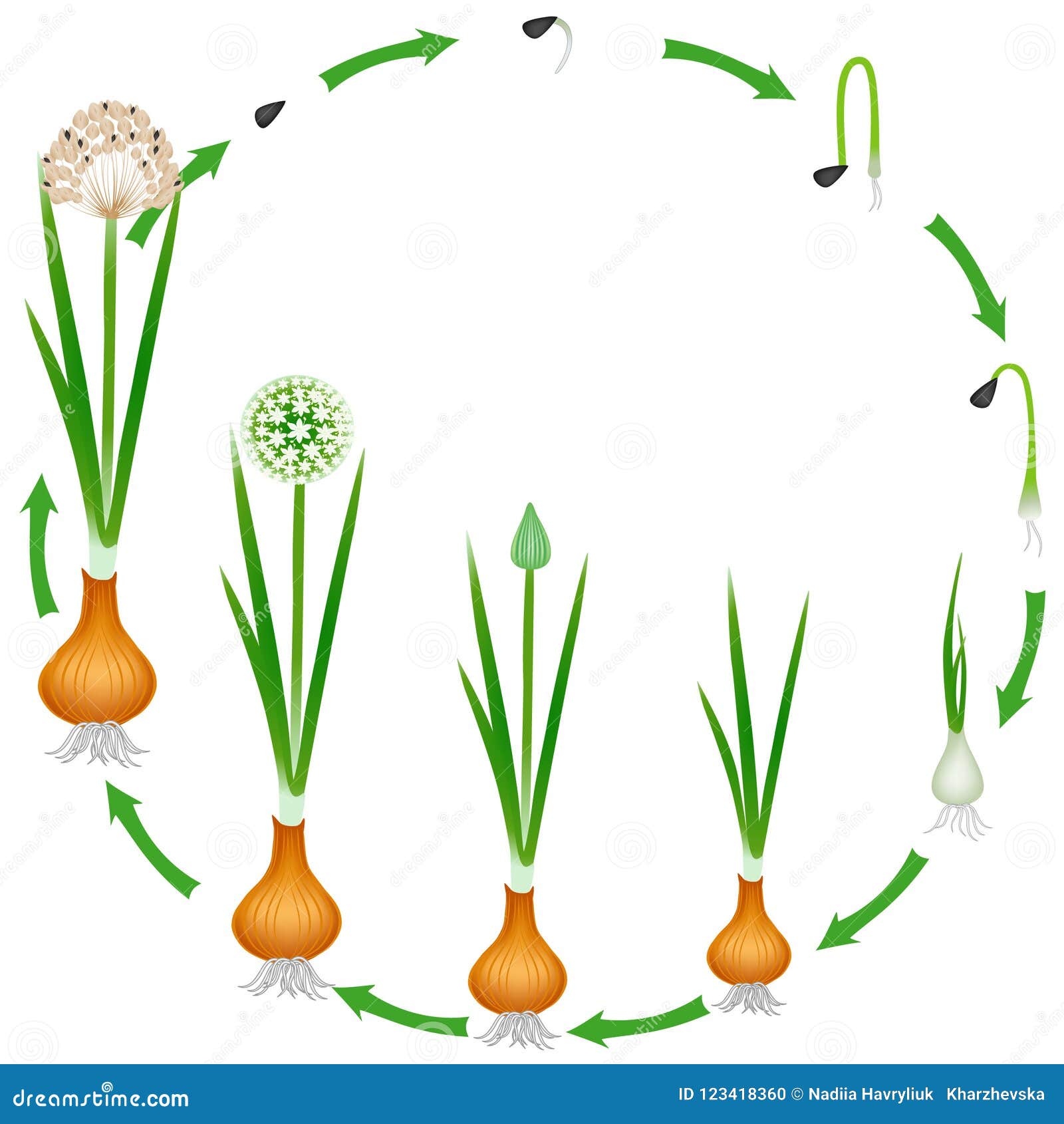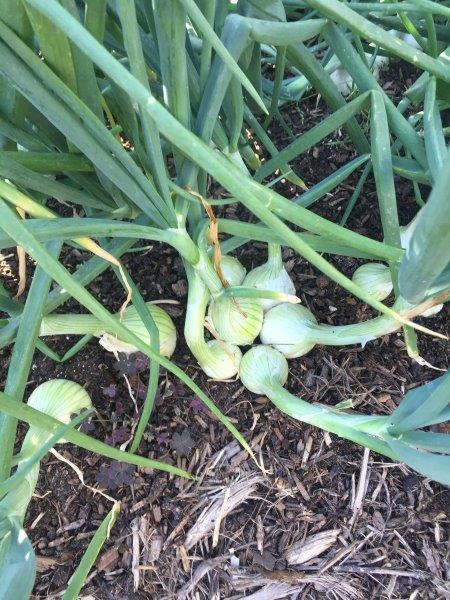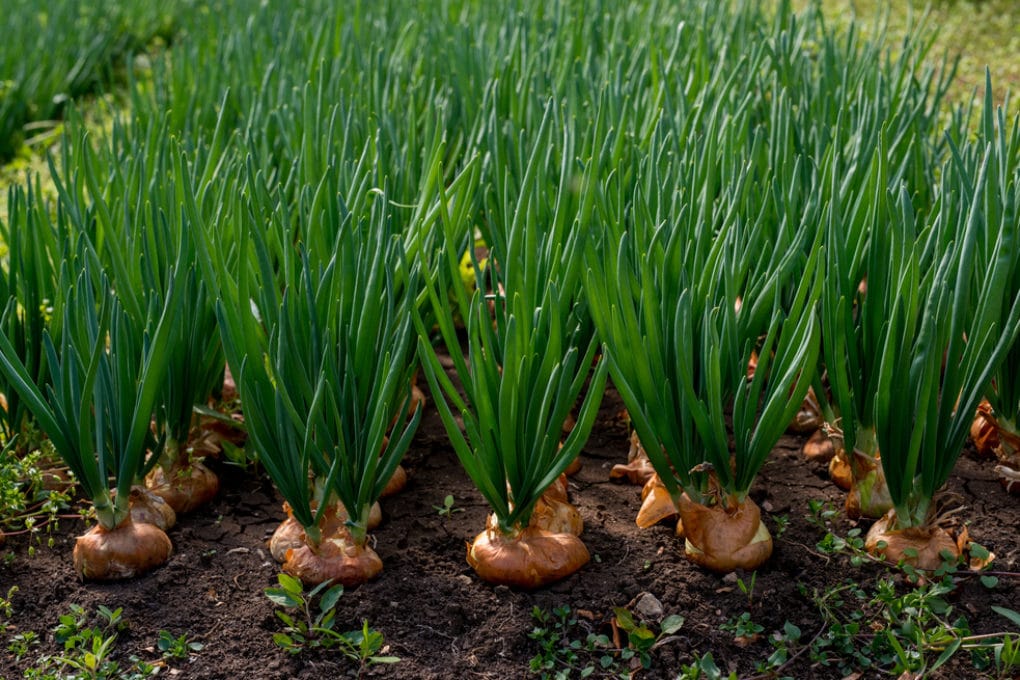Understanding the Onion Life Cycle
Onions are a fundamental ingredient in many cuisines, and understanding their life cycle is crucial for successful cultivation. The onion life cycle consists of several stages, from seed germination to harvest. The entire process can take anywhere from 90 to 120 days, depending on factors such as climate, soil, and light. To answer the question of how long does a onion take to grow, it’s essential to comprehend the different stages of growth.
The onion life cycle begins with seed germination, which typically occurs within 7-10 days after sowing. During this stage, the seed absorbs water, and the embryo begins to grow. The seedling then emerges, and the first set of leaves, known as the cotyledons, appear. As the plant grows, it develops a bulb, which is the edible part of the onion.
The growth stage is critical, as it determines the size and quality of the onion. Factors such as temperature, moisture, and light exposure significantly impact the growth rate. Onions require a consistent temperature between 60-80°F (15-27°C) and adequate moisture to grow. Inadequate light exposure can lead to weak and leggy growth.
As the onion approaches maturity, it begins to form a bulb. This process is triggered by the lengthening of daylight hours and the onset of warmer temperatures. The bulb formation stage is critical, as it determines the size and quality of the onion. Proper care during this stage ensures a healthy and flavorful onion.
Understanding the onion life cycle is essential for successful cultivation. By recognizing the different stages of growth, gardeners can provide optimal conditions for their onions to thrive. This knowledge also helps to answer the question of how long does a onion take to grow, as it allows gardeners to plan and prepare for the harvest.
How to Create the Perfect Environment for Onion Growth
Creating an ideal environment for onion growth is crucial for a successful harvest. Onions require specific conditions to thrive, and understanding these needs can help gardeners optimize their growth. To answer the question of how long does a onion take to grow, it’s essential to consider the environmental factors that influence onion growth.
Soil preparation is a critical step in creating an ideal environment for onion growth. Onions prefer well-draining, fertile soil with a pH between 6.0 and 7.0. Gardeners can achieve this by adding organic matter such as compost or manure to the soil. Additionally, onions require a consistent supply of nutrients, which can be provided through regular fertilization.
Sunlight is another essential factor for onion growth. Onions require full sun to partial shade, depending on the variety. Gardeners should ensure that their onions receive at least 6 hours of direct sunlight per day. In regions with intense sunlight, providing some shade can help prevent scorching.
Watering techniques also play a significant role in onion growth. Onions require consistent moisture, especially during the bulb formation stage. Gardeners should aim to provide about 1 inch of water per week, either through rainfall or irrigation. However, overwatering can be detrimental to onion growth, so it’s essential to monitor soil moisture levels.
Maintaining a consistent temperature and humidity level is also vital for onion growth. Onions prefer daytime temperatures between 60-80°F (15-27°C) and nighttime temperatures around 50-60°F (10-15°C). Gardeners can use mulch or row covers to regulate soil temperature and retain moisture.
By creating an ideal environment for onion growth, gardeners can optimize their chances of a successful harvest. By understanding the specific needs of onions, gardeners can provide the necessary conditions for their onions to thrive, ultimately answering the question of how long does a onion take to grow.
The Role of Variety in Determining Onion Growth Time
Onions come in a wide range of varieties, each with its unique growth characteristics and requirements. The type of onion being grown plays a significant role in determining the growth time, and understanding these differences is essential for optimizing onion growth. To answer the question of how long does a onion take to grow, it’s crucial to consider the specific variety being grown.
There are several types of onions, including yellow, white, red, and sweet onions. Each type has a different growth rate, with some varieties maturing faster than others. For example, yellow onions are one of the most common varieties and typically take around 120-150 days to mature. White onions, on the other hand, take around 150-180 days to mature.
The growth rate of onions is also influenced by factors such as day length, temperature, and moisture. Onions are classified as either long-day or short-day onions, depending on the amount of daylight they require to form bulbs. Long-day onions require 14-16 hours of daylight to form bulbs, while short-day onions require 10-12 hours. Temperature also plays a significant role, with onions growing faster in warmer temperatures.
Moisture levels also impact onion growth, with onions requiring consistent moisture to grow. However, overwatering can lead to rot and other diseases, so it’s essential to monitor soil moisture levels. By understanding the specific needs of the onion variety being grown, gardeners can optimize their growth and answer the question of how long does a onion take to grow.
Some popular onion varieties and their growth times include:
- Yellow onions: 120-150 days
- White onions: 150-180 days
- Red onions: 120-150 days
- Sweet onions: 150-180 days
By selecting the right onion variety for their climate and growing conditions, gardeners can optimize their onion growth and enjoy a bountiful harvest.
From Seed to Harvest: A Step-by-Step Guide to Growing Onions
Growing onions can be a rewarding experience, but it requires careful planning and attention to detail. To answer the question of how long does a onion take to grow, it’s essential to understand the step-by-step process of growing onions. Here’s a comprehensive guide to help you grow healthy and flavorful onions.
Step 1: Seed Selection
Choosing the right onion variety is crucial for a successful harvest. Consider factors such as climate, soil type, and desired flavor profile when selecting a variety. Some popular onion varieties include ‘Yellow Granex’, ‘White Lisbon’, and ‘Redwing’.
Step 2: Sowing
Sow onion seeds in well-draining soil with a pH between 6.0 and 7.0. Plant seeds 1-2 inches deep and 1-2 inches apart, depending on the variety. Water the soil gently but thoroughly after sowing.
Step 3: Thinning
As the seedlings emerge, thin them out to 3-4 inches apart to allow for proper growth. Use scissors or a small tool to carefully remove the weaker seedlings, leaving the strongest ones to grow.
Step 4: Fertilization
Onions require regular fertilization to promote healthy growth. Use a balanced fertilizer (10-10-10) and follow the manufacturer’s instructions for application rates.
Step 5: Pest and Disease Management
Keep an eye out for common onion pests such as aphids, thrips, and onion maggots. Regularly inspect your plants and use organic or chemical controls as needed to prevent infestations.
Step 6: Harvesting
Onions are ready to harvest when the tops begin to yellow and fall over. Use a garden fork to carefully loosen the soil around the onion, then lift it out of the ground. Allow the onion to dry in a warm, dry place for a few days before storing.
By following these steps, you can grow healthy and flavorful onions that will answer the question of how long does a onion take to grow. Remember to be patient and provide your onions with the care and attention they need to thrive.
Factors That Influence Onion Growth Time
Onion growth time can be influenced by a variety of factors, including weather conditions, soil quality, and pest management. Understanding these factors can help gardeners optimize their onion growth and answer the question of how long does a onion take to grow.
Weather conditions, such as temperature, rainfall, and sunlight, can significantly impact onion growth. Onions require a consistent temperature between 60-80°F (15-27°C) to grow. Extreme temperatures, either hot or cold, can slow down or stop onion growth. Rainfall and irrigation also play a crucial role in onion growth, as onions require consistent moisture to grow.
Soil quality is another important factor that influences onion growth time. Onions prefer well-draining, fertile soil with a pH between 6.0 and 7.0. Soil with poor drainage or inadequate nutrients can lead to slow or stunted growth. Gardeners can improve soil quality by adding organic matter such as compost or manure.
Pest management is also crucial for onion growth. Common onion pests include aphids, thrips, and onion maggots. These pests can cause significant damage to onion plants, leading to reduced growth and yield. Gardeners can use integrated pest management techniques, such as crop rotation, biological control, and chemical control, to manage onion pests.
Other factors that can influence onion growth time include day length, temperature, and moisture. Onions are classified as either long-day or short-day onions, depending on the amount of daylight they require to form bulbs. Temperature and moisture also impact onion growth, with onions growing faster in warmer temperatures and consistent moisture.
By understanding the factors that influence onion growth time, gardeners can take steps to optimize their onion growth and answer the question of how long does a onion take to grow. By providing the right conditions and managing pests and diseases, gardeners can enjoy a healthy and flavorful onion crop.
Some common factors that can affect onion growth time include:
- Weather conditions (temperature, rainfall, sunlight)
- Soil quality (drainage, fertility, pH)
- Pest management (aphids, thrips, onion maggots)
- Day length (long-day or short-day onions)
- Temperature (consistent temperature between 60-80°F)
- Moisture (consistent moisture)
By considering these factors, gardeners can optimize their onion growth and enjoy a successful harvest.
How Long Does it Take for Onions to Mature?
One of the most common questions asked by gardeners is how long does a onion take to grow. The answer to this question depends on several factors, including the type of onion, weather conditions, and growing practices. In general, onions take around 120 to 180 days to mature, but this can vary depending on the specific variety and growing conditions.
There are several factors that can affect the growth time of onions, including day length, temperature, and moisture. Onions are classified as either long-day or short-day onions, depending on the amount of daylight they require to form bulbs. Long-day onions require 14-16 hours of daylight to form bulbs, while short-day onions require 10-12 hours. Temperature and moisture also impact onion growth, with onions growing faster in warmer temperatures and consistent moisture.
The average growth time for different onion varieties is as follows:
- Yellow onions: 120-150 days
- White onions: 150-180 days
- Red onions: 120-150 days
- Sweet onions: 150-180 days
It’s worth noting that these are general estimates, and the actual growth time may vary depending on specific growing conditions. Factors such as weather, soil quality, and pest management can all impact onion growth and affect the time it takes for onions to mature.
To give you a better idea of how long it takes for onions to mature, here are some general guidelines:
- Seed germination: 7-10 days
- Seedling establishment: 1-2 weeks
- Bulb formation: 60-90 days
- Maturation: 120-180 days
By understanding the factors that affect onion growth and the average growth time for different varieties, gardeners can better plan and manage their onion crop. This can help ensure a healthy and productive harvest, and answer the question of how long does a onion take to grow.
Tips for Accelerating Onion Growth
Onion growth can be accelerated using various techniques, including fertilization, pruning, and mulching. By incorporating these methods into your onion-growing routine, you can optimize your onion growth and answer the question of how long does a onion take to grow.
Fertilization is a crucial step in accelerating onion growth. Onions require a balanced fertilizer that is high in nitrogen, phosphorus, and potassium. Apply a fertilizer with a ratio of 10-10-10 (nitrogen-phosphorus-potassium) once a month to promote healthy growth.
Pruning is another technique that can accelerate onion growth. Prune your onion plants to encourage bushy growth and prevent them from flowering. Remove any weak or damaged leaves to promote healthy growth and prevent disease.
Mulching is also an effective way to accelerate onion growth. Mulch around the base of your onion plants to retain moisture, suppress weeds, and regulate soil temperature. Use a layer of 2-3 inches of organic mulch such as straw or bark chips.
Other tips for accelerating onion growth include:
- Providing adequate sunlight: Onions require at least 6 hours of direct sunlight per day to grow.
- Watering consistently: Onions require consistent moisture to grow, but make sure not to overwater.
- Using row covers: Row covers can help to retain moisture, suppress weeds, and regulate soil temperature.
- Avoiding pests and diseases: Regularly inspect your onion plants for signs of pests and diseases, and take action promptly to prevent damage.
By incorporating these tips into your onion-growing routine, you can accelerate your onion growth and enjoy a healthy and productive harvest. Remember to always follow best practices for onion growth, and don’t hesitate to seek advice if you have any questions or concerns.
Common Mistakes to Avoid When Growing Onions
Growing onions can be a rewarding experience, but it requires careful attention to detail. To answer the question of how long does a onion take to grow, it’s essential to avoid common mistakes that can impact onion growth. Here are some common mistakes to avoid when growing onions:
Overwatering: Onions require consistent moisture, but overwatering can lead to rot and other diseases. Make sure to check the soil regularly and avoid watering during periods of high rainfall.
Underwatering: On the other hand, underwatering can cause onions to become stressed, leading to reduced growth and flavor. Make sure to provide onions with consistent moisture, especially during periods of high temperature.
Inadequate sunlight: Onions require at least 6 hours of direct sunlight per day to grow. Make sure to plant onions in a location that receives sufficient sunlight.
Poor soil quality: Onions require well-draining, fertile soil to grow. Make sure to test your soil regularly and amend it as necessary to ensure optimal growth.
Pests and diseases: Onions are susceptible to pests and diseases such as aphids, thrips, and fungal infections. Make sure to monitor your onion crop regularly and take action promptly to prevent damage.
Incorrect fertilization: Onions require a balanced fertilizer that is high in nitrogen, phosphorus, and potassium. Make sure to fertilize your onions regularly, but avoid overfertilizing, which can lead to reduced growth and flavor.
By avoiding these common mistakes, you can ensure a healthy and productive onion crop. Remember to always follow best practices for onion growth, and don’t hesitate to seek advice if you have any questions or concerns.
Some additional tips to keep in mind when growing onions include:
- Plant onions at the right time: Onions are typically planted in the spring or fall, depending on the variety.
- Use the right variety: Different onion varieties have different growth times and requirements. Make sure to choose a variety that is suitable for your climate and growing conditions.
- Monitor for pests and diseases: Regularly inspect your onion crop for signs of pests and diseases, and take action promptly to prevent damage.
By following these tips and avoiding common mistakes, you can ensure a successful onion harvest and answer the question of how long does a onion take to grow.






:max_bytes(150000):strip_icc()/growing-onions-1403447-03-ed15005936eb49069e0dc0c0565e98cb.jpg)

:max_bytes(150000):strip_icc()/growing-onions-1403447-04-a1058b6dc67e4b1cadac626d5185c6ba.jpg)
